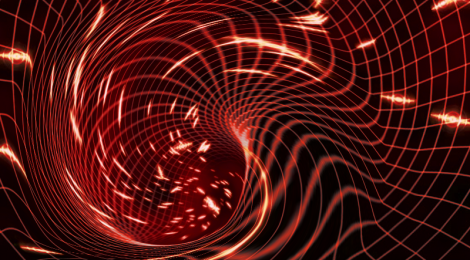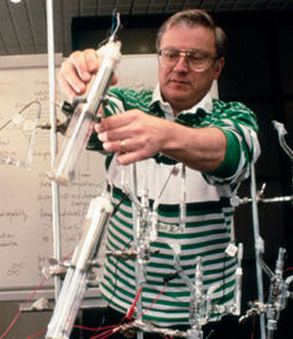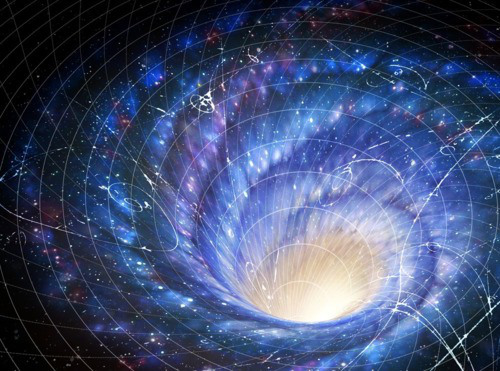
The Fleischmann Singularity
Pons and Fleischmann created a singularity in 1988
It was one of those moments in science that transforms our understanding of the atom
Some few years ago (2006) I was sitting in Martin Fleischmann’s parlour in the South of England. He had invited me to come chat with him about my work which at the time was going on under the banner of my company D2Fusion. After getting lost trying to find his tiny village of Tisbury and ending up in nearby Stonehenge I finally made it. I spent a long afternoon with Martin talking over the history of cold fusion and his search for gentle energy. One particular story I was keen to hear was of the melting event in the lab in Utah that was shrouded in mystery. Over time I have come to think that mysterious event was the creation of a what must be named a ‘Fleischmann singularity’.
As Martin told me the story he and Stan had been conducting many electrochemical loading experiments with heavy water and palladium. One long running experiment was with a largish cube of palladium, as I recall about a 1 cm cube. It had been sitting for a very long time, months, in the typical electrolysis bath of heavy water into which a bit of lithium had been introduced to help the electrolyte. It was one of those experiments that explorers often have on the ‘back of the bench’ to watch over a long time frame.
As it happened over a weekend where Stan and Martin were not going to be around the lab Stan’s son was tasked with peeking in on the lab to make sure all was in order. When he did so he saw that the cube experiment lay shattered and broken on the lab bench and in the bench was a hole as if something had burned through it from the experiment. Stan’s son telephoned to report the news and Stan and Martin sprang into action to see what might have happened.
When they examined the lab bench and remains of the experiment they noted that indeed something had not only burned its way through the bench but had also burned down and out of sight into the concrete floor of the basement lab. The basement lab was in the large chemistry building with a massive concrete foundation at the University of Utah where Professor Pons was the chair of the department.

In 1979 the movie China Syndrome told of a nuclear melting event where the core melts down into the earth
Much was done to try to get to the bottom of what happened and no explanation could be arrived at save that the palladium had become and sustained being impossibly hot and produced a mini ‘China Syndrome’ event. Mysteriously the palladium was gone.
What happened next?
The conditions of the experiment were seemingly quite benign. A tiny amount of DC current amounting a 1 watt or so was being used to electrolyze the heavy water. Oxygen was being produced and bubbled up at the platinum anode and deuterium, heavy hydrogen, bubbled at the palladium cathode cube. Palladium being a sponge for hydrogen was also soaking up the deuterium and that palladium cathode may have been holding as many atoms of deuterium as there were palladium atoms. Surely those deuteriums were not uniformly distributed in the metal but rather concentrated in special locations. This was Fleischmann’s perfect recipe for cold fusion.
Martin noted that the measure of the density (fugacity) of the heavy hydrogen isotope deuterium electrochemically loaded into palladium surely exceeded that of metallic hydrogen. Indeed he mused to me the calculations based on his measurements put the density of that heavy hydrogen as being well beyond metallic and similar to the density of hydrogen inside the center of a star! Here’s a paper on just how this is sure to happen and shows hydrogen at the density of white dwarfs and supernova that comes from the HOT fusion world.
Stan Pons, then chairman of the chemistry department at Utah was a former graduate student of Fleischmann’s. As Martin told me he recently had moved from his active career as a professor of chemistry to professor emeritus at the University of South Hampton in England and could now, without risking his retirement, take on some of the more out of the box lines of research that he’d been secretly investigating for decades. Stan was more than willing to be his partner in this pioneering and courageous work.
Martin told me he had first glimpsed cold fusion in his reading about hydrogen in metals in 1949 and long thereafter had been on the trail that he noted tracked even further back into the 1930’s. But these ideas were so out of the box of traditional scientific dogma it was just too hot to handle while upholding the duties of a prominent teaching professor.
Beyond Cold Fusion
I asked Martin whether he had tried to repeat the palladium cube melt down experiment. His reply was a dramatic and emphatic NO, he said he thought it far too dangerous to do so. He figured they got away with it once without dire consequences — a second time they might not be so lucky. Just what it was that destroyed that experiment he noted “was perhaps even beyond than cold fusion.” The energy required to do the damage they observed was simply beyond anything they could imagine. It was surely nuclear if not beyond so. Fleischmann and Pons dutifully informed nuclear authorities and were flummoxed when they were simply dismissed as reporting the impossible. ‘Fools’ is what Martin called them.
Martin and Stan did continue on their much smaller scale experiments with tiny palladium cathodes that were typically about 1 cm long and the diameter of a toothpick. These were producing reliable anomalous heat that was far beyond any conceivable chemical energy source. Eventually they were able to produce boiling cells that would sustain boiling temperatures for weeks on end and even continue long after the electrolyzing current was shut off!
This is what they reported in their March 1989 press conference, watch a short video below, that started the world on a long path toward cold fusion energy.
The singularity mystery remains
How does a few grams of molten palladium metal burn through a lab bench and deep into the concrete basement floor of a large building.
Surely this is a question that begs for an answer. As the molted palladium was first contained in a beaker of water sitting on a lab bench something had to take place to make it rapidly get very hot. Palladium melts at 1600 degree C. At that temperature molten palladium is brilliantly white hot, as blindingly bright as the brightest search light.
Presumably the suddenly white hot cube of palladium flashed the heavy water in the beaker to stream and shattered the beaker. It then proceeded to burn through the chemistry lab bench-top which are typically made of heat resistant materials. Then it dropped to the concrete floor. All of the time one might presume it was cooling off as it boiled and burned its way through the bench to the floor.
Once on the concrete floor it was in contact with a very large cold mass of concrete that surely was capable of dissipating the heat from the molten metal rapidly. Anyone with experience in welding and working with molten metals knows that should have been the end of the heat as tiny amounts of molten metals even white hot metals, in this case something with a volume of less than a single cube of sugar, spilled onto concrete can never burned deeply into the concrete.
So somehow the heat had not merely appeared moments before while the experiment was running in the beaker it was continuing to be produced and under this circumstance the sustained 1600 degree C puddle of molten palladium would vaporize the concrete as long as energy was available.
No ordinary explanation of some character of palladium and chemistry can accommodate the observations. Not even I would say is even the most likely ‘out of the box cold fusion explanation’ of a mixture or palladium and heavy hydrogen. Something else must have been happening. The reacting mixture of palladium and deuterium may well have transcended ordinary matter and become a large quark mass, not for long, but long enough to burn itself out of existence.
Might such a large mass, even just milligrams being large, of quark matter have come to exist. Would it be as hot as a star and rapidly worm its way out of our space time into quantum space and dimensions.
Other explanations are invited?
CERN super collider might fuse hydrogen nuclei into mini black holes

Formation of a mini black hole in the CERN super collider via the fusion of two protons into dense quark matter
At the most elaborate and modern cathedral of classical physics, the CERN super collider, thousands of scientists focus their attention on what happens when two protons (hydrogen nuclei) are brought very close together through energetic collisions. As CERN protons collide they transform for a flickering moment from being two independent protons into a tiny bag of quark matter. That sub-atomic bit of strange matter is surrounded by layers of detectors tens of meters thick resulting data/science that provides clues for unravelling mysteries of both the atom and the universe.
If you want a quick video lesson on CERN check out the LHC RAP that should have won a Grammy.
Without the overhead of the super collider (~$20 billion to date) Fleischmann’s teacup of cold solid state fusion clearly attains this same state of fusion of hydrogen nuclei under conditions that Fleischmann had shown in a lifetime of studies of hydrogen loading into metals that the density and therefore the closeness of hydrogen nuclei was as extraordinary as inside a metal lattice as inside the super collider.
Cold fusion being a process where matter that reaches a quark state proceeds slowly without the release of the high energy radiation of its high energy counterparts in hot fusion. It’s as if cold fusion enjoys the life within the bounds of the Irish blessing, “may you be half an hour in heaven before the devil knows you’re dead.” That brief moment of time is sufficient for that cold formed solid state quark matter to worm its way out of our domain leaving just a trail of heat behind.
We know that black holes form in space when certain stars, much larger than our Sun, collapse on themselves at the end of their lives. They concentrate a very large amount of matter in a very small space. They become so dense in this quark matter state that the gravity they exert is such that not even light can travel out of their blackness.
Speculations about black holes at the LHC refer to particles produced in the collisions of pairs of protons. These are subatomic – or quantum – black holes. Scientists are not at all sure that quantum black holes exist but evidence for them is one of the things the world is spending countless billions at CERN to try to find.
The physical part of the LHC experiments – colliding particles – happens in nature all the time. We know, for example, that the Earth is constantly bombarded by cosmic rays: when high energy cosmic rays hit the atmosphere, particles are colliding with one another in much the same way, many with vastly higher energies as in the collisions planned at the LHC. Subatomic black holes could be forming and worming their way into other dimensions in our atmosphere constantly.
What if collisions at the LHC produced a black hole? Where would it go. Would it just be pulled by gravity down into the Earth until it disappeared. That is the assumption and the source of endless speculation by the thousands of scientists working at CERN and elsewhere.

CERN-LHC Celebrates success in glimpsing the fleeting God Particle but has yet to reveal finding the wormhole to heaven.
The creation of a quantum black hole at the LHC would be very surprising, but very exciting indeed. It would allow physicists to learn about nature’s most elusive force – gravity. Remember: particle collisions happen all the time in nature, and we’re all still here. If you would like to read up more on the safety of the LHC, there is more information here.
.
.
What would be the significance of the creation of a black hole at the LHC or elsewhere?
The creation of a black hole at the LHC would confirm theories that our universe is not 4 dimensional (3 space plus 1 time dimensions), but indeed hosts other dimensions. It would be quite a spectacular philosophical outcome! In the same way that the theory of relativity or of quantum mechanics revolutionized our way of thinking, discovering the existence of extra dimensions would be a major new milestone in our understanding of the Universe.
While some boffins at CERN suggest there is no obvious application for knowing this. Other CERN folks acknowledge that many people will start speculating about using these extra dimensions for space and time travel, or as a source of clean energy, and who knows what else. It is rather tempting to compare it to the discovery of magnetism by the Phoenicians who could not foresee that electricity and magnetism would completely reshape modern life…
Many think that the late great Martin Fleischmann ( and his colleague Stanley Pons) already delivered the practical application for the merging of hydrogen nuclei into quark matter with the resulting release of incredible useful gentle energy.
As the melting palladium experiment illustrated Martin may have not made it into the history books as a “STAR” but he is most certainly the father of one.
* I am reminded that another account of the melting event has been written Charles Beaudette’s book “Excess Heat – Why Cold Fusion Research Prevailed.”
My own plans include repeating the Fleischmann singularity experiment early this year. Or perhaps it might better be called the Fleishmann/Dyson Sphere experiment.


